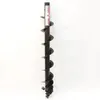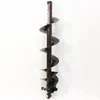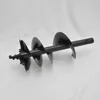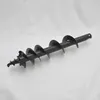Post hole diggers are essential tools for a variety of outdoor projects, from installing fences and decks to setting up mailboxes and garden structures. These tools are designed to efficiently excavate cylindrical holes in the ground with minimal effort. Whether you're a DIY enthusiast or a professional contractor, having the right post hole digger can save time and ensure precision in your work. In this guide, we'll explore the different types of post hole diggers, their key features, and how to choose the best one for your needs. We'll also provide detailed product specifications in an easy-to-read format, along with answers to frequently asked questions to help you make an informed decision.
Post hole diggers come in several varieties, each suited to different tasks and user preferences. The main types include manual post hole diggers, powered augers, and tractor-mounted models. Manual diggers are ideal for small projects and offer portability, while powered augers provide more power for larger or tougher jobs. Tractor-mounted diggers are best for heavy-duty commercial use. Understanding these types will help you select the most appropriate tool for your specific application.
When selecting a post hole digger, it's important to consider various features and specifications that impact performance. These include digging depth, diameter capacity, power source, weight, and material construction. Below is a detailed table outlining common specifications for different types of post hole diggers, based on popular models in the market. This information will assist you in comparing products and finding the right fit for your project requirements.
| Type | Digging Depth (inches) | Diameter Range (inches) | Power Source | Weight (lbs) | Material |
|---|---|---|---|---|---|
| Manual | Up to 36 | 4 - 12 | Manual (human power) | 5 - 15 | Steel with wooden handles |
| Powered Auger (Gas) | Up to 48 | 6 - 24 | Gasoline engine | 40 - 100 | Steel and alloy components |
| Powered Auger (Electric) | Up to 36 | 4 - 12 | Electric motor | 20 - 50 | Steel with plastic housing |
| Tractor-Mounted | Up to 72 | 8 - 36 | Hydraulic or PTO | 200 - 500 | Heavy-duty steel |
Additional features to look for include adjustable handles for ergonomics, anti-vibration systems for comfort, and safety mechanisms like clutch controls. Always check the manufacturer's guidelines for compatibility with your soil type and project scale.
Using a post hole digger offers numerous advantages over alternative methods like shovels or manual digging. These tools provide greater efficiency, accuracy, and reduced physical strain. For instance, powered augers can complete holes in minutes versus hours with manual labor. They also ensure consistent hole dimensions, which is crucial for structural stability in fencing or construction. Moreover, modern post hole diggers are designed with user safety and comfort in mind, featuring ergonomic designs and protective elements to minimize injury risks.
Selecting the appropriate post hole digger depends on several factors, such as the scale of your project, soil conditions, budget, and your physical capability. For small, infrequent tasks in soft soil, a manual digger may suffice. For larger projects or harder ground, a powered auger is recommended. Consider the power source: gas models offer mobility but require maintenance, while electric models are quieter and eco-friendly but need a power source. Tractor-mounted units are ideal for professional use with access to machinery. Always read product reviews and specifications to ensure compatibility with your needs.
Here are some common questions and detailed answers about post hole diggers to help clarify any uncertainties and guide your purchase decision.
What is the average cost of a post hole digger?
The cost varies widely based on type and features. Manual post hole diggers typically range from $30 to $100, while powered augers can cost between $200 and $1000. Tractor-mounted models may start at $500 and go up to $3000 or more, depending on size and capabilities.
How do I maintain a post hole digger?
Regular maintenance includes cleaning after use to remove dirt and debris, lubricating moving parts, and checking for wear. For powered models, follow the manufacturer's instructions for engine or motor care, such as changing oil or inspecting electrical components. Store in a dry place to prevent rust.
Can post hole diggers handle rocky soil?
Yes, but it depends on the type. Manual diggers may struggle with rocks, while powered augers with sharp, hardened auger bits can often cut through small rocks. For very rocky terrain, consider a heavy-duty model or pre-loosening the soil with a digging bar.
What safety precautions should I take when using a post hole digger?
Always wear protective gear, including gloves, safety glasses, and sturdy boots. Keep hands and feet away from moving parts, and ensure the area is clear of underground utilities before digging. For powered models, operate on stable ground and follow all safety guidelines in the manual.
Are there eco-friendly options for post hole diggers?
Yes, electric and battery-powered models are more environmentally friendly than gas-powered ones, as they produce no emissions. Some manual diggers are also made from sustainable materials. Look for energy-efficient certifications if available.
How deep can a post hole digger go?
Depth capabilities vary: manual diggers often reach up to 36 inches, powered augers up to 48 inches, and tractor-mounted models can dig beyond 72 inches. Always check the product specifications for maximum depth based on the auger size and power.
Can I use a post hole digger for planting trees?
Absolutely! Post hole diggers are excellent for digging holes for tree planting, as they create neat, deep holes that promote healthy root growth. Choose a diameter appropriate for the tree's root ball and ensure the depth matches planting guidelines.
What is the difference between a one-man and two-man auger?
One-man augers are designed for solo operation and are generally lighter with lower power, suitable for smaller holes. Two-man augers require two people to handle, offering more stability and power for larger diameters and tougher soil, reducing the risk of kickback.
How do I choose the right auger bit size?
Select an auger bit based on the post diameter you're installing. For example, for a 4x4 wood post, a 6-8 inch auger is common. Refer to project requirements or consult a sizing chart from the manufacturer to ensure proper fit and stability.
Are post hole diggers easy to transport?
Manual diggers are highly portable due to their light weight and compact size. Powered augers may be heavier but often come with wheels or breakdown features for easier transport. Tractor-mounted models require a vehicle for movement but are stationary during use.





